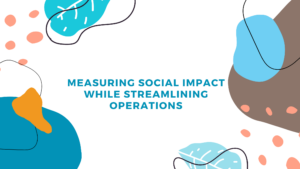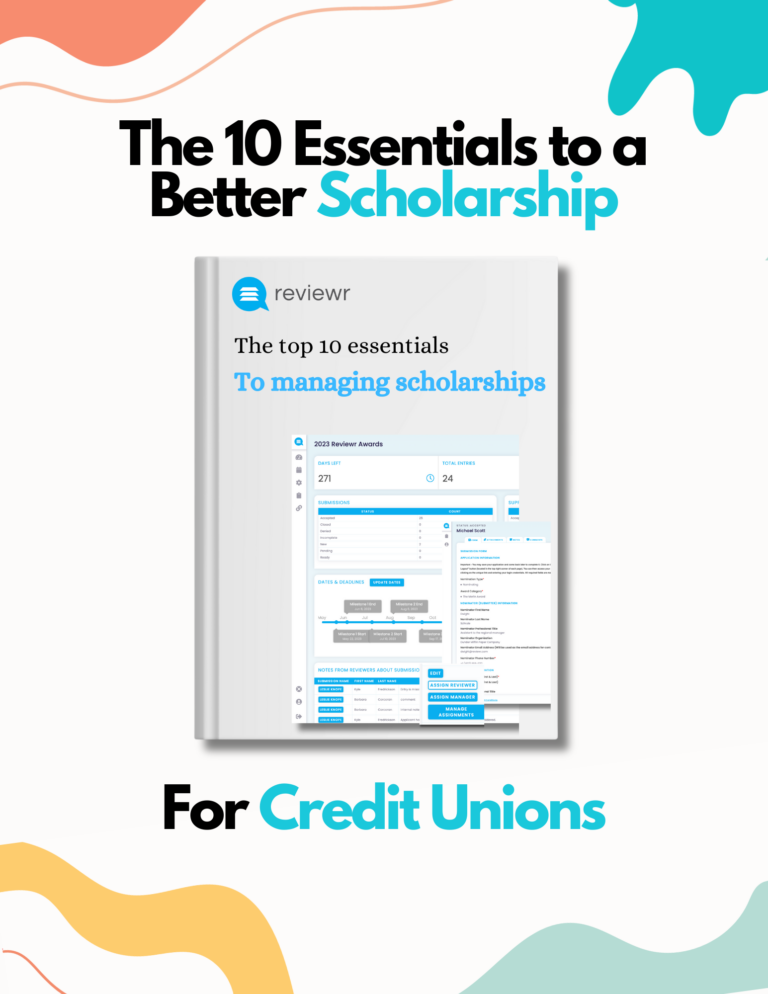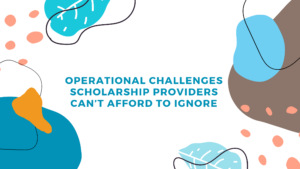The 10 essentials to better scholarship
Discover how Credit Unions can revolutionize their scholarship programs using the latest Scholarship Management Software. This comprehensive webinar/blog delves into 10 proven best practices to scholarship management, showcasing how to enhance every aspect of your scholarship offerings—from application collection to post-selection engagement.
Introduction to Effective Scholarship Management
Scholarship programs are a vital component of Credit Union community engagement, providing members with valuable educational opportunities. However, managing these programs can be complex. Enter Scholarship Management Software: the solution to streamline processes, ensuring fairness, compliance, and impact. With so many moving parts to a successful scholarship campaign, this webinar/blog highlights the top 10 key components for scholarship managers.
1. Proof of Process (PoP)
Description: A foundational element that assures transparency and clarity about the scholarship process. The Proof of Process simply outlines – “When you apply to our scholarship, here is what to expect and the process your application will go through”.
- Public Statement: Details every phase of the scholarship process.
- Expectation Setting: Sets transparent expectations for applicants.
- Components:
- Clear timelines and deadlines.
- Application open date
- Application close date
- Data review and cleansing period
- Phase 1 review
- Phase 2 review
- Final selection
- Announcements
- Description of the application process.
- Details on the portal being used to collect applications
- Note: this portal must be a dedicated, proven, scholarship management software with SOC2Type2 compliance.
- This sets the expectations and reputation of the scholarship provider. Imagine outlining a proof of process or running a scholarship through online web forms, downloadable documents, emails, spreadsheets, etc. Besides the administrative nightmare of managing this complexity, it almost certainly makes managing the program in a compliant, fair, and equitable manner impossible.
- Showcase the questions that will be asked
- Note which questions will impact the review and selection, why, and how.
- Note which questions will be blinded to the review team.
- Note which questions are considered private and confidential.
- Showcase the reference request template
- This allows applicants to see what references will be requested to submit.
- Outline data security and privacy protocols
- Reviewr has this covered on behalf of clients with full SOC2Type2 documentation, audits, etc.
- Outlines the review and selection processes.
- Outline the grant application software that will be used for review and selection – similar to the scholarship application process imagine a compliant review process using spreadsheets, web forms, file sharing, emails, etc.
- Details on how many phases of review will occur
- Insight into how many evaluators will review each scholarship application
- The submissions will be assigned to evaluators randomly
- Each evaluator will leverage a scoring rubric for a quantitative evaluation
- Outline the exact scholarship evaluation criteria that will be used
- Private and confidential data will be blinded from the review team
- Any information not relevant to the review and selection will be blinded by the review team
- Reference answers will be taken into consideration, but not letters – only answers to the template questions for data consistency.
- Outline of post-scholarship procedures.
- Notify both scholarship recipients and non-recipients
- Provide access back into the scholarship management software that powered the scholarship program
- Grant access to both the scoresheets that were used for evaluation as well as any comments/feedback left for applicants
- Transparency
- Self-development
- Showcases that the process was followed (Proof of Process)
2. 24/7 Application Collection
Description: Advocates for the year-round collection of applications to boost engagement and participation.
- Continuous Engagement: Keeps the application portal open all year.
- Marketing Opportunities: Utilizes the application period for targeted marketing campaigns.
- Core Components:
- Consider either collecting applications 24/7 or doing an intent to submit
- Intent applications can be added to marketing campaigns
- Increases conversion rates for participation
- Generates program marketing opportunities all year
- Applicants can be added to education based marketing campaigns that drive credit union mission
- Account signups
- Financial literacy
- Education awareness
- Conduct quarterly, bi-annually, or annual reviews
- Collect 24/7 with dedicated review and selection windows
- Adds extra complexity managing multiple workflows at the same time
- Need a tool to assist
- Collect apps, review apps, manage scholarship recipients all at the same time.
3. Reference Collection Revolution
Description: Streamlines reference collection by replacing traditional letters with standardized templates.
- Template-Based References: Simplifies the reference process for referees and applicants.
- Automated Process: Facilitates the easy collection and organization of references.
- Core Components:
- Avoid reference letters
- Historically references were collected in a letter format but this is now an outdated and risky method.
- Letters create a barrier for references.
- Hard to write
- Takes time and effort
- Multi-step to create, write, and send back.
- Not all references are created equal – some are better written than others, some had more time put into it, etc. Is this a fair representation of the scholarship applicant?
- Hard to blind PII in a letter.
- Leverage reference templates
- Outline 3-5 questions that each reference should answer.
- Lowers the time and effort barrier for references.
- Creates data consistency amongst all applicants.
- Creates consistency in the review process with defined data sets.
- Use Reviewrs automated reference collection process
- Scholarship applicant will enter the name and email of the reference
- Triggers an email notification to reference
- Reference clicks on a link that brings them to a reference template
- Reference simply fills out the template with the ability to save, log out, and work at their own pace.
- Visibility to both scholarship program managers as well as to applicants on the progress of references.
- Actual reference content can be blinded from the applicant.
- Upon submission, the reference template is automatically attached to the applicant profile.
- Reference data can be blinded more easily by the review team.


4. AI Detection and Management
Description: Introduces measures to identify and manage AI-generated content in scholarship applications.
- Balanced Use of AI: Recognizes the benefits and challenges of AI in scholarship applications.
- Proactive Monitoring: Utilizes tools to detect AI contributions.
- Core Components:
- AI in general, but specifically in scholarships is only going to continue growing
- AI is not a bad thing, it’s just something that needs to be monitored
- Outside of operational efficiencies for program management, it can help applicants create stronger, authentic, essays.
- With that said, Reviewr believes that by the end of the year 70%+ of scholarship essays will be written by AI
- We must be able to identify content written by AI and flag it for review
- Again, leveraging AI is not a bad thing, and the modern consumer is going to leverage it as a tool.
- The concern isnt if AI was used, its how much was it used

5. Impartial Review Workflow
Description: Ensures a fair review process through randomized distribution of applications and workload management.
- Fair Distribution: Randomly assigns applications to reviewers.
- Workflow Efficiency: Balances reviewer workloads to maintain review quality.
- Core Components:
- Depending on volume, sometimes it can be overwhelming to ask review team members to evaluate all scholarship applications.
- If evaluators are overwhelmed, their review and selection process is often degraded, leading to potentially inaccurate and unfair reviews and selections.
- Instead, start with a survey of the review team to define how many applicants they can provide 100% of their energy towards. This becomes the target.
- However, scholarship review members being assigned only a subset of the total application pool adds a risk element to who is reviewing who.
- Leverage Reviewr automation where an exact number can be entered (Assign each evaluator 9 submissions, assign each evaluator no less than 5 but no more than 7, I want every applicant reviewed 7 times, etc).
- Reviewr will then automatically, and randomly, distribute submissions to reviewers based on the input. By removing the human element of deciding which applicants are reviewed by which staff members, we can ensure compliance.
- Consider the use of a “normalization report” that a) identifies each evaluators average score, b) sets a baseline for their average, and c) takes into consideration that baseline for final results. This levels the playing field for applicants that may have been evaluated by an evaluator with stricter judging parameters.

6. Blind Judging
Description: Removes bias by concealing applicants’ personal information during the review process.
- Objective Evaluation: Focuses on the application’s content, not the applicant’s identity.
- Data Privacy: Ensures sensitive information is hidden from reviewers.
- Core Components:
- Blind PII from the evaluation team
- Not only is it important to remove personal identifiers from the review team to avoid a biased, non-equitable, review but it is also a data security risk sharing PII with external users.
- Blind “non-critical” information
- Often times scholarship applications include essential bookkeeping and data but it’s not essential for the actual review in the selection process – meaning the data collected will not be used in making scholarship selection decisions. In this use case, the data should be blinded from reviewers so as to also provide an engaging and non-overwhelming experience for them.
- Dedicated scholarship management software
- While it is impossible to completely eliminate the possibility for review team members to export, screenshot, or save information – using a dedicated scholarship management system such as Reviewr does make it significantly more challenging to ensure that data collected in Reviewr stays in Reviewr.

7. Quantitative Scoring
Description: Employs a data-driven approach to evaluate applications, ensuring objective and transparent selections.
- Data-Driven Framework: Utilizes scorecards for objective assessments.
- Mission Alignment: Ensures the scoring criteria reflect the credit union’s values.
- Core Components:
- Scorecards should match the scholarship application and scholarship provider’s guiding vision and principles.
- The Proof of Process lays out why specific scholarship questions are being asked – the scoresheet needs to mirror those.
- Example, volunteer experience GPA, family needs, etc.
- This allows the review team to side by side review the scholarship application and references with a scoresheet that follows along. The review team simply plugs in their answers as they read the application.
- Consider weighted scoring
- While the scoresheet should mirror the questions answered in the application, some scholarship application questions are in more alignment with the scholarship provider’s mission than others – these should be weighted to reflect.
- For example: If a plumbing trade association is offering a scholarship but that trade association specializes in pipefitting – then those students who are pursuing that career would get weighted higher for answering that question.
- Other examples include weighting volunteer activity over grades, grades over intangibles, or essay writing.
- Use a scholarship management system such as Reviewr to auto-result tabulation and leaderboards.
- It’s critical to remove potential human error when tabulating scholarship results on a quantitative basis. Leverage Reviewr automation which calculates the quantitative results based on the scorecard input by the review teams. This will then outline non-bias, and fair, rankings.

8. Consolidation and Post-Selection Management
Description: Centralizes post-selection activities to streamline management and maintain engagement with recipients.
- Efficient Management: Provides a unified platform for managing post-selection activities.
- Engagement with Recipients: Facilitates ongoing communication and submission of required documents.
- Core Components:
- Avoid leveraging technology and tools for 90% of the program but deviate for the remaining 10%.
- Ensure Proof of Process and compliance
- Post selection data management is arguably more challenging
- Lower the barrier for participants
- Keep data organized and efficient
- Especially important with concurrent workflows
- Measure impact and year over year program KPI’s
9. Engagement Surveys
Description: Utilizes feedback from participants to continuously refine and improve the scholarship program.
- Continuous Improvement: Leverages surveys to gather insights for program enhancements.
- Impact Assessment: Measures the program’s success in achieving its objectives.
- Core Components:
- Avoid becoming complacent
- We offer scholarships for a reason – what is that reason and are we achieving our mission?
- How are we measuring impact?
- Applicants impacted
- Monetary amounts
- scholarships funded
- This needs to align with mission and vision
- Program continuality and the “snowball effect”
- We want incremental improvements
- How do we create a self reliant program that doesn’t rely on a sole individual
- Accountability
- People, process, and product feedback
- We can only resolve/grow if we are aware
- Example: Review team workload management
10. Data Security and Compliance
Description: Prioritizes the security of applicant data and ensures compliance with regulatory standards.
- Building Trust: Secures sensitive applicant information to foster trust.
- Regulatory Compliance: Meets industry standards for data protection and privacy.
- Core Components:
- Essential to build community trust
- Believe it or not, lack of security control can be a deterrent for applicants
- These are mission critical opportunities for participants, they need to be treated as such.
- In a highly audited industry we must ensure compliance
- SOC2TYPE2 compliance
- Evolving industry standard regulations and laws
- Accessibility standards
-
Conclusion
For Credit Unions looking to enhance their scholarship programs, leveraging the right strategies and technologies is key. From streamlining application processes to ensuring data security and compliance, the steps outlined in this guide provide a roadmap for success. Implementing these best practices will not only simplify scholarship management but also amplify the impact of your program, benefiting both your Credit Union and its members.










